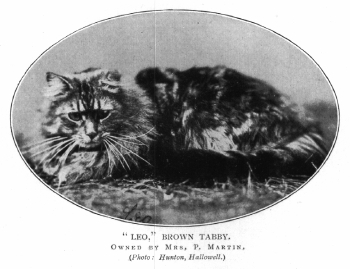History of the breed and legends
The Maine Coon Cat is America's first indigenous show cat. A dozen of these down-east, working class heroes were listed in the program of a show held in Boston in January 1878. Often called the "gentle giants" of the cat fancy, the Maine Coon Cat's origins are shrouded in the mists of time and the legends told by their owners.
 Many people once believed the Maine Coon Cat originated by interbreeding the American bobcat with the domestic cats brought to North America on the various sailing ships that came to the Northeastern seaboard. Probably the tufted ears and feet of the Maine Coon Cat, which are similar to the bobcat's, gave some credence to this legend. The tuft curls outward from the inside of the ears and tufts of fur are found between the toes. Taking fantasy one step farther is the belief that the domestic cats of New England bred with raccoons. The early Maine Coon Cats may simply have looked like raccoons to the natives, since the brown tabby, with its bushy ringed tail, occurs most commonly in nature. The Maine Coon Cat also converses occasionally with an endearing trill or chirp, somewhat like the cry of a young raccoon. It is genetically impossible for domestic cats to breed with either raccoons or bobcats, as we in the cat fancy know, because they are of different genera and do not hybridize.
Many people once believed the Maine Coon Cat originated by interbreeding the American bobcat with the domestic cats brought to North America on the various sailing ships that came to the Northeastern seaboard. Probably the tufted ears and feet of the Maine Coon Cat, which are similar to the bobcat's, gave some credence to this legend. The tuft curls outward from the inside of the ears and tufts of fur are found between the toes. Taking fantasy one step farther is the belief that the domestic cats of New England bred with raccoons. The early Maine Coon Cats may simply have looked like raccoons to the natives, since the brown tabby, with its bushy ringed tail, occurs most commonly in nature. The Maine Coon Cat also converses occasionally with an endearing trill or chirp, somewhat like the cry of a young raccoon. It is genetically impossible for domestic cats to breed with either raccoons or bobcats, as we in the cat fancy know, because they are of different genera and do not hybridize.
Another tale is that the Maine Coon Cat's ancestors came from Norwegian Skogkatts brought over by the Vikings. A letter from Mrs. Jack Bjonness to Mrs. Rod Ljostad describes them as follows: "The head is longer than that of the shorthaired domestic. The coat is about half as long as that of the Persian. They come in all colors, the ears are high with lynx tufts, the whole cat is 'tall' not Cobby like a Persian. But no one could say it is a slender cat. They are "hardy."
More romantic versions of the Maine Coon Cat's development have been handed down over the years. The first involves Captain Samuel Clough and Marie Antoinette. Captain Clough was one of the principals (or so the legend goes) in a plot designed to smuggle the French queen out of France and bring her to Wiscasset, Maine. The scheme was cut short, but not before Clough had loaded his ship, the Sally, with luxurious furnishings, priceless bric-a-brac, some of the queen's personal belongings, and six of her favorite pet cats. While Clough waited, there was a sudden outburst of violence. Marie Antoinette was seized, and eventually beheaded. Captain Clough had to make sail with all haste to escape repercussions for his part in the attempted rescue and with him went the queen's possessions and the six longhaired cats still in his care. It is assumed that the queen's cats bred with the American cats and voilˆ - the origin of the Maine Coon Cat.
A more logical conclusion is that the Maine Coon Cat developed from the domestic shorthaired cats of settlers who came to America with all their worldly goods and the family pet. Later, as the country became more civilized and the trading ships returned from their travels, the sailors returned with longhaired cats. The new longhaired cats in turn bred with the local shorthaired cats and began populating the Eastern seaboard, and thus began the survival of the fittest. Those cats that survived the harsh New England winters produced the next generation of kittens. After nature finished combining the genetic ingredients of form, coat, and substance of the Maine Coon Cat, man looked upon these cats and said, "that is some pretty good cat." It was to be expected that these intelligent cats would find their way into the settlers' homes and become beloved pets as well as good workers (mousers). It was during the 1860s that farmers would tell stories and brag about the powers and intelligence of their Maine Coon Cats. During this decade these same farmers began having their own cat show at the Skowhegan Fair where Maine Coon Cats from all over the territory competed for the title "Maine State Champion Coon Cat."
Retrieved from CFA website


